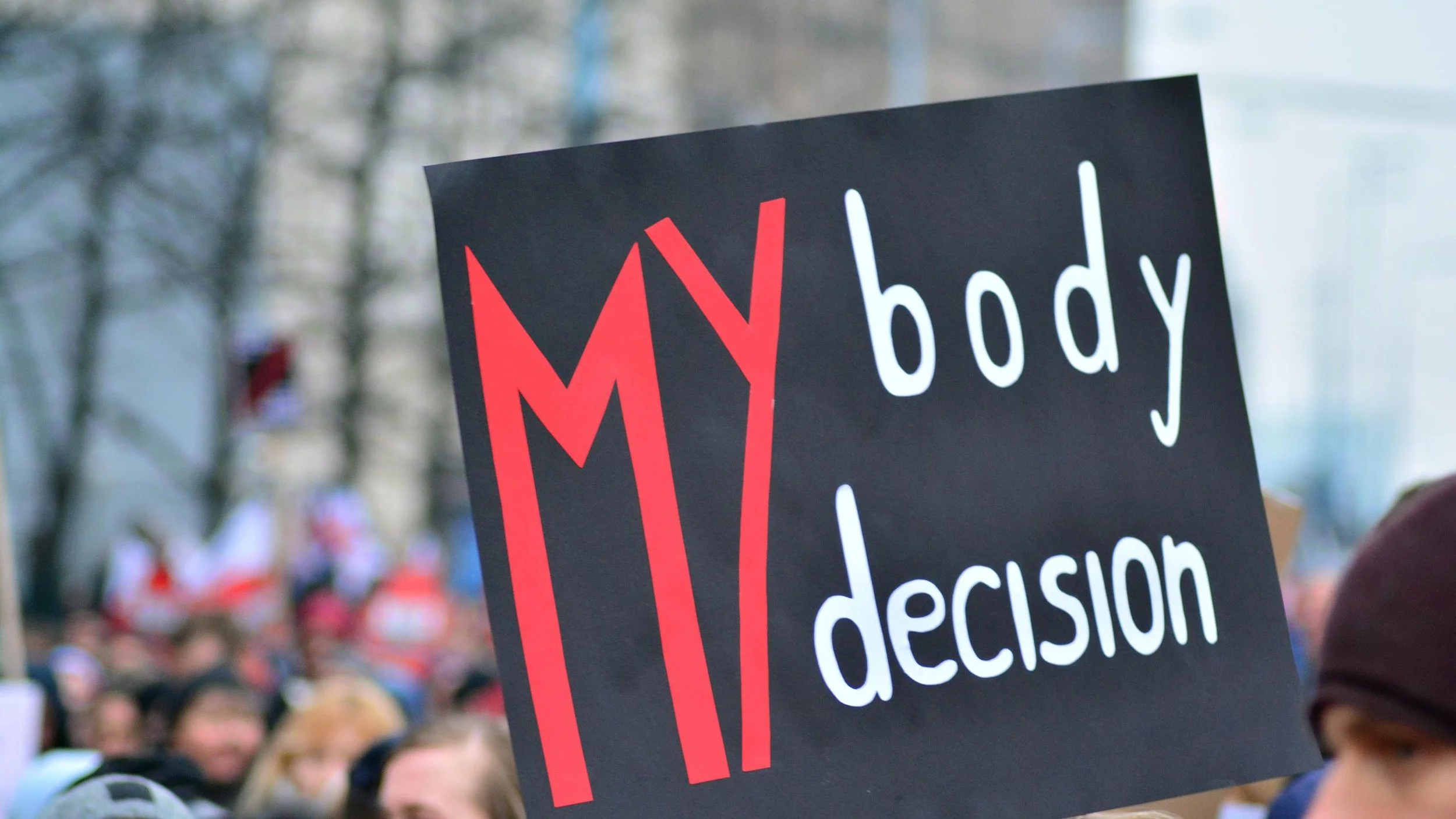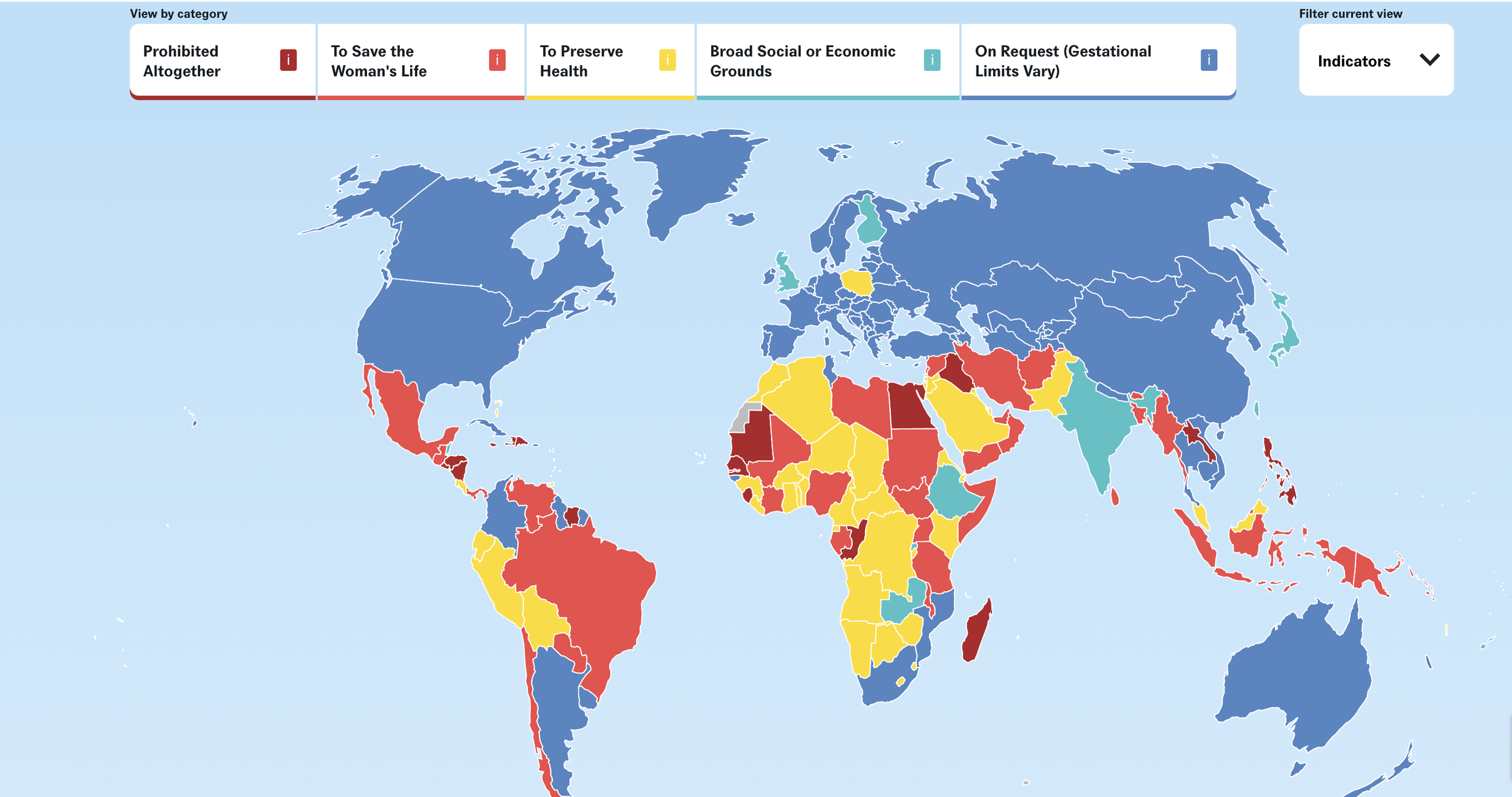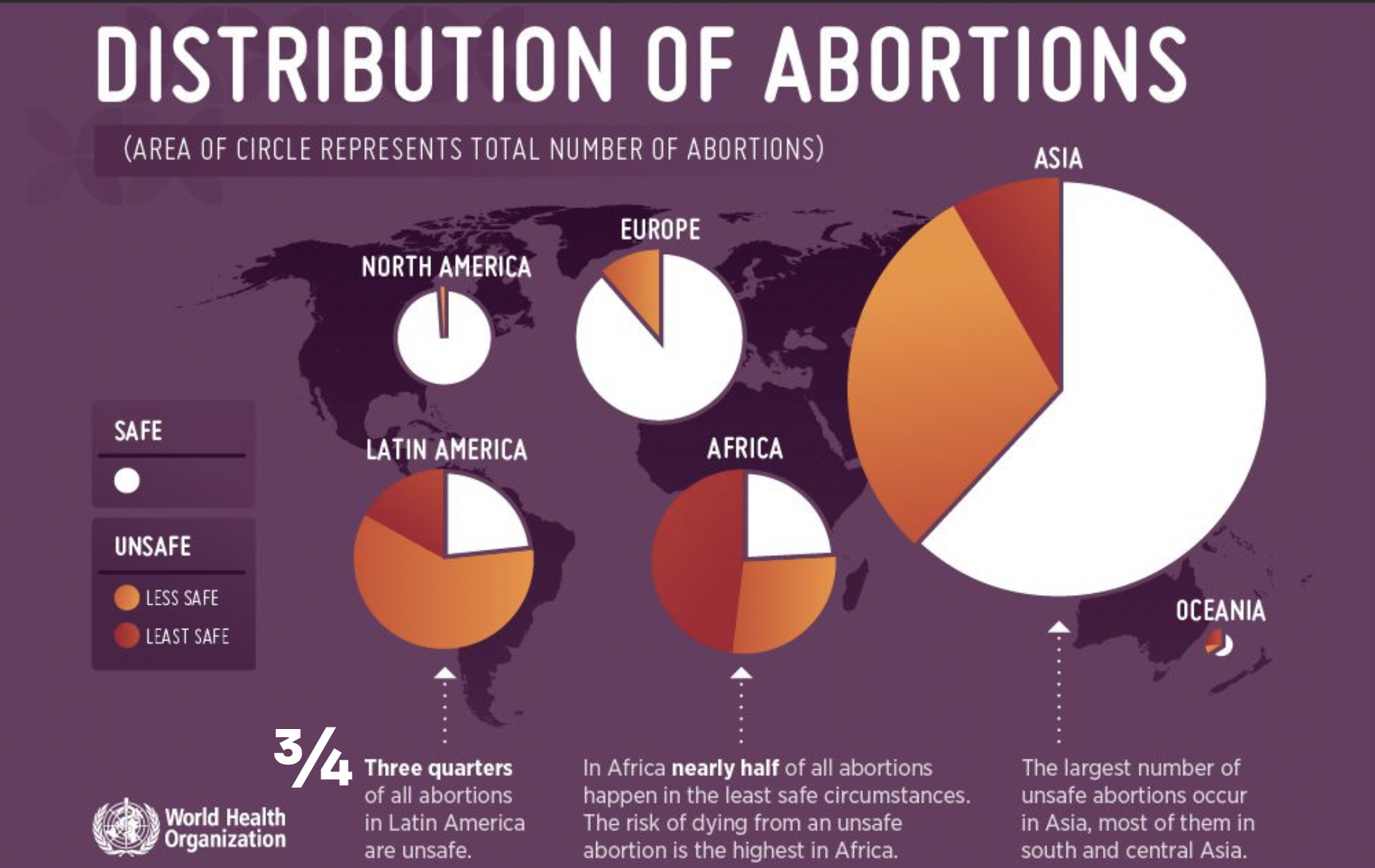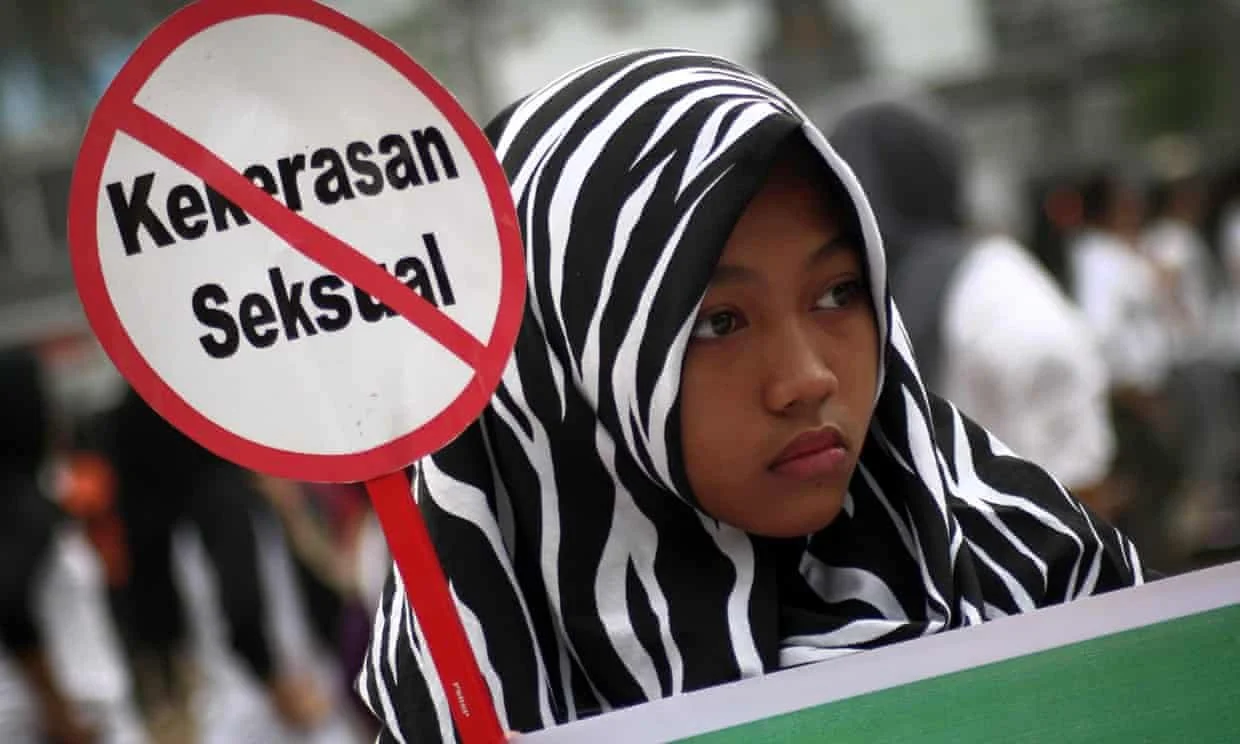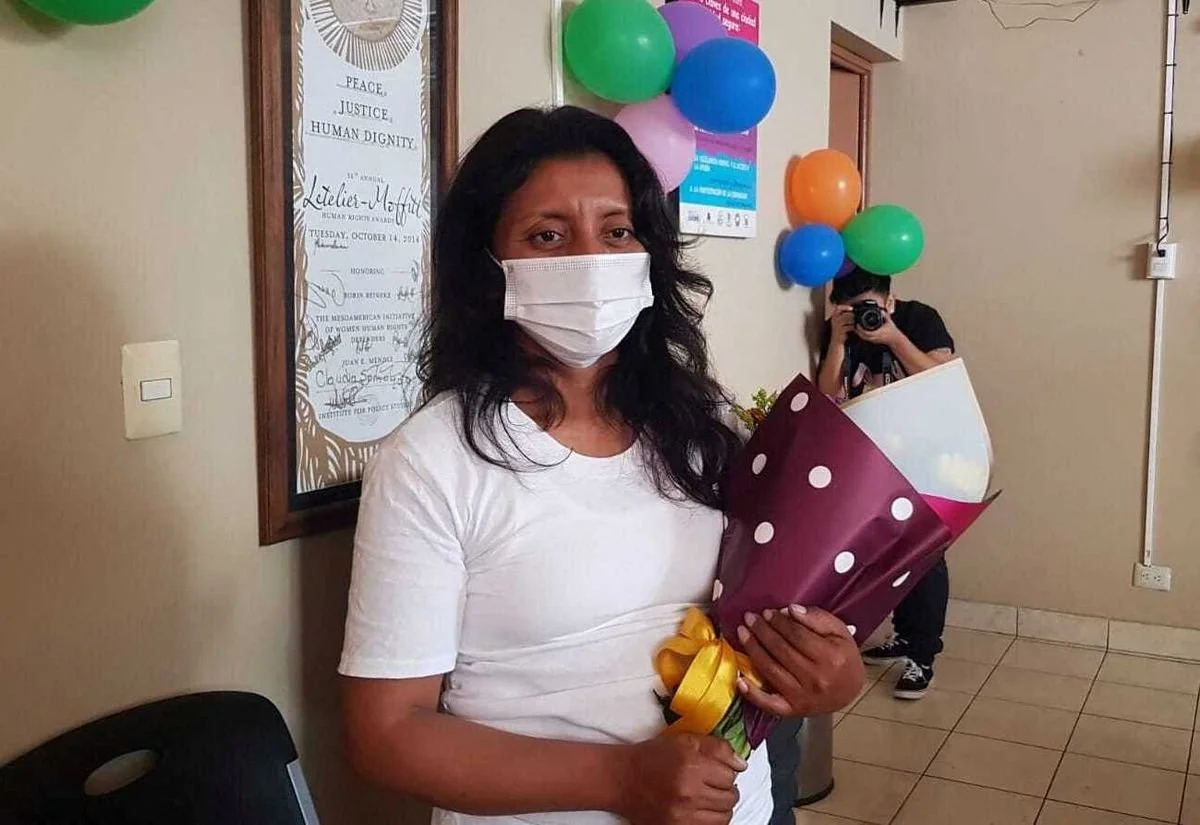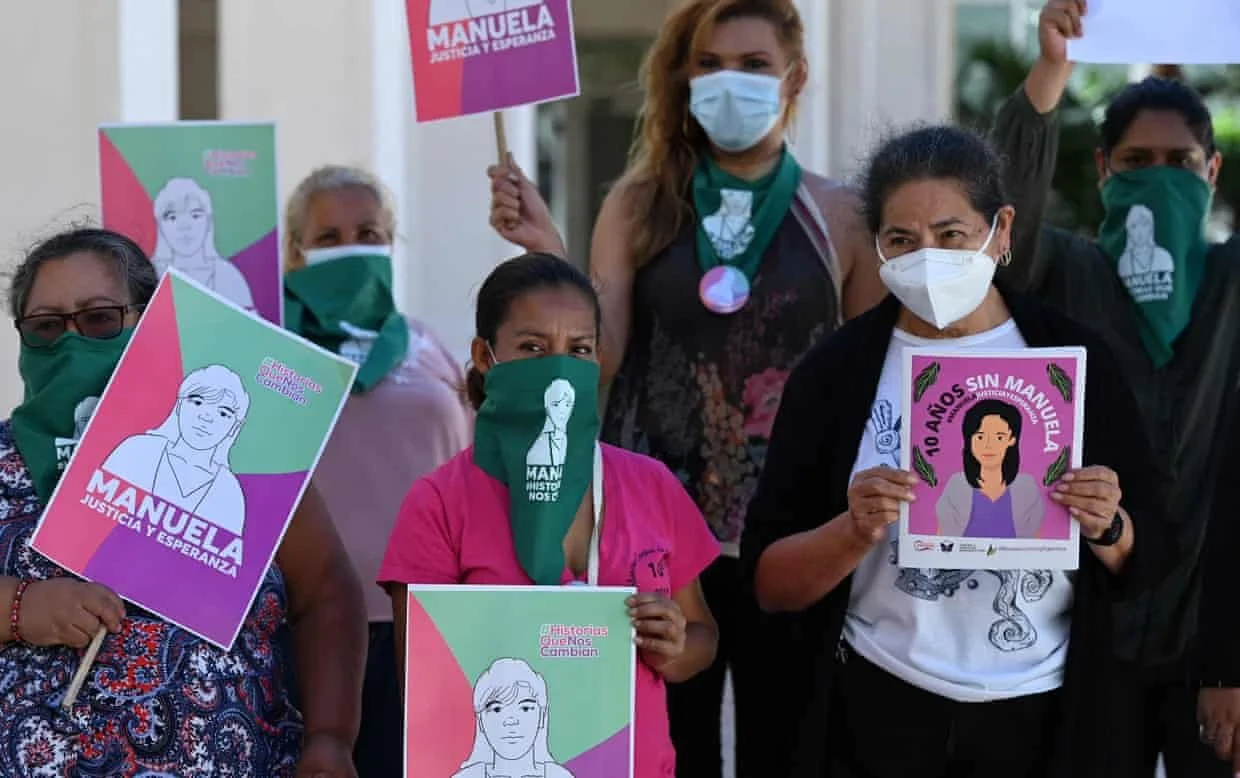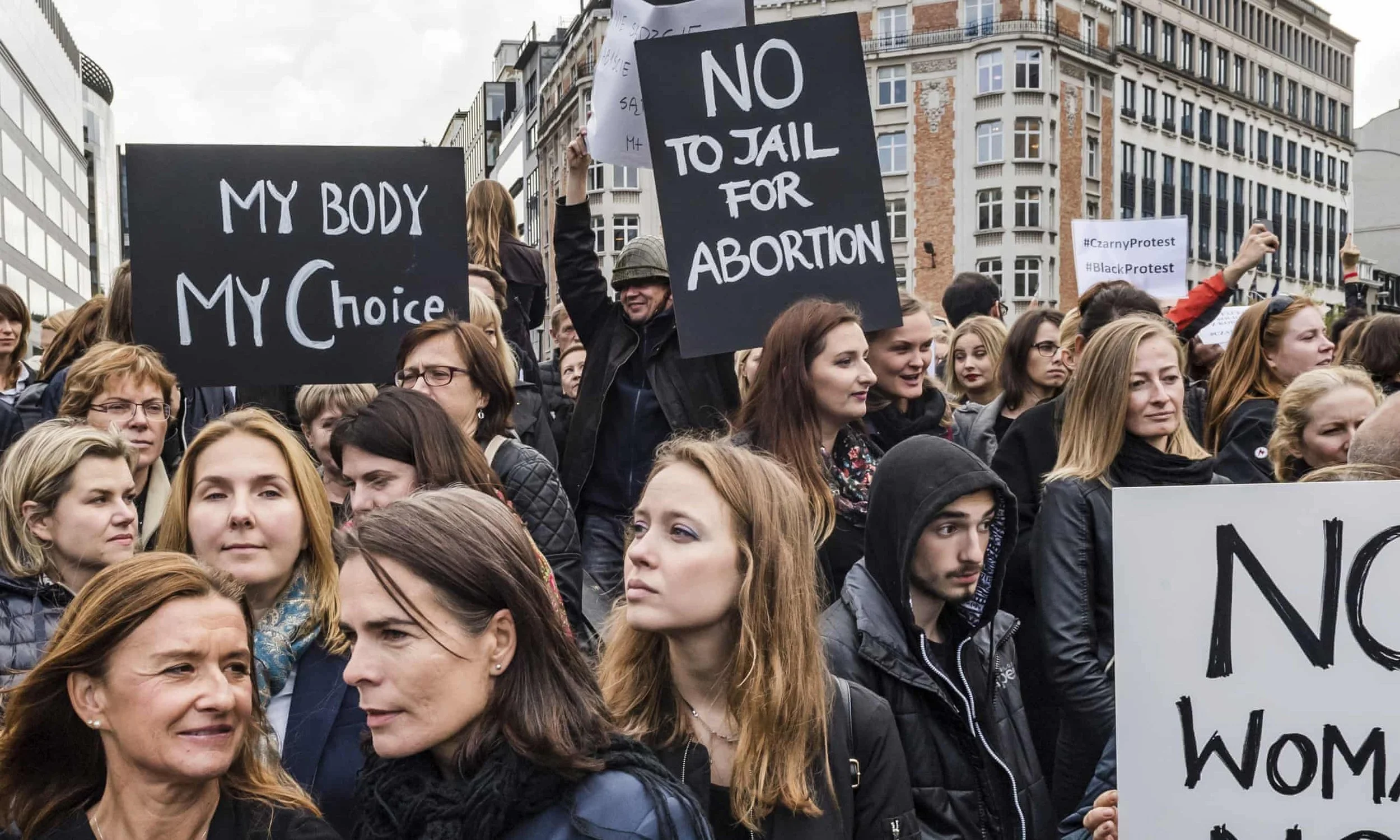Are Women Losing the Fight for Abortion Rights?
An anonymous woman is scared and alone. She has been forced to search for an abortion illegally because of her government’s limitations on available services. She is putting herself at risk because the suffering that would come from having the child would be much worse. This woman has no name because she represents the World Health Organization’s estimated 450 million women that do not have access to safe and legal abortions. However, this number doesn’t include the many women that struggle to access services due to their location or income.
Financial issues and minimal government support have led millions of women to risk their health and safety to receive an abortion, even in areas where it's legal. Despite the already lack of services, developed nations, like the United States, could soon make it even more difficult for women to access safe and legal abortions. At a time when technology and medicine are so advanced, it seems barbaric that safe abortion services are becoming less available in a large portion of the world.
The State of Unsafe Abortions
The World Health Organization estimates that 45% of all abortions performed from 2010–2014 were, by their definition, unsafe. Latin America, Africa, or Asia account for nearly all (97%) unsafe abortions. The WHO’s definition of a safe abortion is one that is “performed by a trained health worker using a WHO-recommended method appropriate to the pregnancy duration.”
Unsafe abortions can fall into two categories; less safe and least safe. Less safe defines an abortion “performed by a trained provider using an unsafe or outdated method such as ‘sharp curettage’, or by an untrained person albeit using a safe method like misoprostol, a drug that can be used for many medical purposes, including having an abortion.” This accounts for around one-third of abortions in the study. The second category, least safe, defines an abortion “provided by untrained persons using dangerous methods, such as the introduction of foreign objects and use of herbal concoctions.” In the WHO study, 14% of abortions were labeled as the least safe.
However, the statistics from the WHO could be inaccurate due to the lack of resources for gathering data in undeveloped regions. A considerable portion of women who receive an unsafe or illegal abortion will most likely keep quiet about it and have the procedure off the record. There is no way to track these abortions, especially when they occur in areas where records are not always available.
Misoprostol
One of the methods labeled as safe by the WHO is misoprostol, a pill originally used for stomach ulcers. In recent history, the pill has been used for self-induced abortions before the 11th week of pregnancy. In the past, women were forced to resort to more primitive and dangerous methods. In several areas where abortion services are limited or unavailable, women are now able to get in contact with an outside provider that will send them misoprostol in the mail. In regions where the pill has not been approved, it can be purchased from illegal drug markets.
This method of abortion, however, is still considered to be “less safe” by the WHO because of the risk of improper usage. There have, unfortunately, still been hospitalizations caused by misoprostol. When women order the pill through the mail, they may lack proper instructions for dosage and usage. However, the risks of a self-induced abortion are reduced tremendously with the availability of misoprostol. But this doesn’t ease the suffering that women experience when their government fails to provide them access to abortion services.
Women still feel scared and isolated when they have to look elsewhere for reproductive healthcare. In the 21st century, it’s outrageous that women should have to travel to extreme lengths to receive a safe abortion. In several places, limitations are put into place because of religious values. But these values have blocked all women from receiving an abortion in order to relieve a possible lifetime of suffering.
The Middle East
In Arab countries, abortion laws mainly depend on their interpretation of Islam. A 2013 Pew Research study found that 75% of Muslims from 24 countries believed that abortion was morally wrong. Most regions hold strict laws because of this majority view on abortion. But the laws don’t take into account the other 25% that may need access to an abortion. Maya Margit from The Media Line reports that women, if financially able, can seek out private doctors that will conduct the procedure for a high cost. This is one instance where limitations on abortion services only affect the poor population.
There has been little movement on reproductive rights in several Arab countries because of ongoing conflicts that are taking precedence. Because of this, Independent groups in Arab countries are providing abortion services to those in the most desperate need.
For example, in Iraq, abortions are completely illegal. A locally funded clinic, Nujeen for Family Democratizing Organization, provides abortions to women and girls who have been held captive and released from ISIS. This service is secretive and limited. It provides help only to women in the most crucial need. But there is an entire population of Arab women outside of this that will continue to look for abortion services, mostly in improper conditions.
Turkey and Tunisia hold the most lenient laws on abortion in the Middle East. Turkey allows abortions either 10 or 20 weeks after conception, depending on the circumstances. But women in Turkey still need permission from their husbands and doctors to carry out the procedure and only 8% of public hospitals offer abortion services. It’s apparent that even in areas that provide “on-demand” abortions, there are several obstacles to overcome.
Southeast Asia
In Southeast Asia, abortion laws are lenient in India, Nepal, Vietnam, and Thailand. India recently legalized abortion up to 24 weeks instead of the previous 20. Handfuls of women flock to these countries for abortion services because of the unavailability in their current region. Despite recent improvements on reproductive healthcare, World Bank Blogs reports that Southeast Asian women account for one-fourth of maternal mortality. The Guttmacher Institute found that 60–90% of abortions performed in India, Nepal, and Bangladesh were done illegally. On paper, some areas like India seem to be moving in the right direction but it’s not always shown through government action.
Thailand legalized abortions in the first trimester in February of this year. A case of rape or health risk is no longer necessary during the first 12 weeks. But Aljazeera writer, Zsombor Peter, reports that Thai pro-choice supporters are not satisfied with the small step toward complete reproductive rights. Still, little is being done to make the public aware of the already limited services.
There is minimal support for women looking for an abortion, especially in rural areas that are far away from medical centers. Bansari Kamdar, a writer from The Diplomat, reports that only 40% of women in Nepal were aware of legal abortions, despite its legalization in 2002. Again, the lack of safe and accessible services drives pregnant women to seek out alternate methods. One of the most common tactics is to visit a foreign country and receive an unsafe abortion from an untrained individual.
Women in Southeast Asia go to great lengths to cross country lines because of the harsh punishment they would receive from their government. For example, a 15-year-old girl in Jakarta, Indonesia was sentenced to six months in prison after receiving an illegal abortion. She was raped by her older brother and was unable to go through legal procedures.
Indonesian law states that abortion can only take place in the first six weeks of pregnancy by a trained professional followed by counseling. But the girl from Jakarta was not aware of her pregnancy until the six weeks had passed, blocking her from all safe and legal services. She is one of the many women, worldwide, who get an illegal abortion because it’s their only option. Her case differs because she was punished for it. Women in Southeast Asia and other parts of the world are travel to other countries for the same unsafe and illegal abortions to avoid additional criminal charges.
Latin America
Latin American countries that have strong religious values have also proven to reject their people’s need for reproductive healthcare. Specifically, in El Salvador, where abortion is banned without exception, The Atlantic estimates that one-third of pregnancies still end in abortion. The laws are only pushing pregnant women to unsafe and off-record procedures. Women feel hopeless when the government restricts their access and forces them to go through with a pregnancy. Teen suicides account for three-eighths of maternal mortality rates in El Salvador. The government, however, doesn’t feel they are doing enough to punish women who wish to have an abortion.
Doctors are encouraged to report women to the authorities if they have a “suspicious miscarriage.” But there is no medical way to prove if a pregnancy ended because of abortion or natural causes. Several cases of false imprisonment have occurred because of these reports. The impoverished population was hit hardest because the majority of the reports came from public hospitals.
For example, Elsy, a Salvadorian woman, was sentenced to 30 years in prison for aggravated homicide after experiencing a miscarriage. She rushed to the hospital for a medical emergency but when the doctors discovered she had a miscarriage she was quickly arrested. After 10 years, the charges were dropped and she was released in February. Unfortunately, not all women are as “lucky” as Elsy.
Another Salvadorian woman, known only as Manuela, was also jailed after she suffered a miscarriage. She passed away from cancer while serving her thirty-year sentence. An international court has charged the Salvadorian government with being responsible for Manuela’s death. Authorities are accused of providing inadequate treatment to Manuela while she was in their care.
But Elsy and Manuela are not alone. The Guardian reports, in El Salvador alone, there are over 180 women who have faced charges in relation to a miscarriage. If science cannot prove whether the miscarriage was self-induced or not, there should not be a possibility of prosecution.
Poland
Women in Poland face similar obstacles when it comes to juggling abortion laws and religious values. Because of this, a large portion of the Polish population is against abortion. However, women should still be able to make that choice for themselves. Certain circumstances will arise that don’t fit into the Polish government’s tight guidelines for legal abortion.
Since the fall of the Communist rule, abortion in Poland was only allowed in three cases; rape or incest, a risk to the woman’s life, and severe fetal deformities. Because public opinion skewed heavily against abortion, access to these services was few and far between.
But in 2020, the law changed, and legal abortions became even more scarce. The third circumstance, fetal deformity, was eliminated. This was clearly done to hurt women’s reproductive rights because almost all abortions in Poland were carried-out under the third circumstance. Polish party leader, Jaroslaw Kaczynski, said “Even pregnancies… where a child is sure to die… [should] end with the mother giving birth so the child can be baptized, buried, and have a name.” The trauma a woman might go through is no longer taken under consideration in favor of religious values.
Polish medical professionals now fear prosecution and are putting patients’ lives at risk. One woman, Agnieszka, passed away earlier this year after doctors refused to remove her fetus, even after its heart had stopped beating. She was pregnant with twins at the time and the doctors did not want to risk the second fetus in accordance with the new law. However, they waited another two days after the second fetus had passed to remove them. Agnieszka's family suspects she passed from septic shock but the hospital did not determine a cause of death.
She is one of a number of women in Poland who die because medical professionals are unsure about protocol. The government and the doctors point the blame at each other and innocent women are getting caught in the middle.
Poland is a developed nation and it might be shocking for some to see their strong stance on abortion. However, there are similarities between Poland and our home front, the United States.
Abortion in the United States
Women’s reproductive rights were constantly at risk until 1973 when the Supreme Court made a historic ruling on Roe vs Wade. But like Poland, the majority in power are beginning to lean back towards traditional and religious values. The nail in the coffin for abortion rights was the addition of Justice Amy Cohen Barret State to the Supreme Court in 2020. Taking matters into their own hands, several state governments have begun implementing laws on abortion in an attempt to overrule the 50-year-old federal court ruling.
Texas was the first to instate a new law on abortion that contradicts Roe. The new legislation allows citizens (not public officials) to sue abortion providers or anyone else that helps a woman receive an abortion after six weeks. The unique tactic of having the public prosecute makes the law very difficult to strike down in federal court. There is no exception to the law, even in cases of rape or incest. Doctors are already anticipating an influx of questions concerning out-of-state abortions. To avoid potential lawsuits, nearly all abortion services have ceased in Texas.
Mississippi also proposed legislation that would make abortion illegal beyond the 15th week with narrow exceptions in medical emergencies. The Supreme Court will decide in June whether or not to accept Mississippi’s proposal and, in turn, overrule Roe v. Wade.
If this happens, according to the Guttmacher Institute, 21 states will immediately implement some form of legislation to restrict abortions. These include near-total bans, six-week bans, eight-week bans, and “trigger” bans. Five more states are most likely to apply one of the previous bans if Roe is lifted. The analysis done by the Guttmacher Institute does not take into account the trending hostility toward abortion rights in the other 24 states.
If the Supreme Court continues to be lenient on Texas and Mississippi, other states may follow suit and enforce their own legislation that counters Roe. This development is a slippery slope that could eventually end federally protected abortion rights.
Looking Elsewhere
At a time when many governments are turning their backs on women, outside organizations open their arms to help. Trained professionals in different parts of the globe have banded together to create programs like Women Help Women, Women on the Web, and Aid Access. They provide consultation, prescription, and post-counseling services for women in areas without access to abortions. The introduction of misoprostol took traveling out of the equation, making it possible for women to stay home throughout the process.
One of the most popular “abortion by mail” services is Women Help Women. However, it is not available in the United States. Dr. Rebecca Gomperts from the Netherlands decided to step in and help women in the US in conservative states.
“I don’t care about six weeks. It’s another law that is not based on any scientific evidence, human rights, common sense,” says Dr. Gomperts. “I will provide [prescription for abortion pills] until 10 weeks of pregnancy like I’ve always done.”
When the FDA tried suing Dr. Gomperts and Aid Access, she retaliated with a lawsuit for women’s right to abortion. There have been no recent efforts to stop Aid Access since the countersuit. It seems almost comical for abortion access to be limited in the United States, one of the most developed nations in the world.
Positive Changes in Argentina and Columbia
Developing nations are stepping up to the plate when it comes to reproductive rights. The global women’s movement has put abortion rights in the spotlight, especially in South America. There have been recent law changes that have changed the state of abortion in Colombia and Argentina.
Argentina legalized abortion in late 2020. The government saw the problem of unsafe abortions as a social issue rather than a religious or political one. The leading cause of maternal mortality in Argentina was unsafe abortions. The majority of these deaths were impoverished individuals who could not afford to receive an abortion from a private medical provider. The legislation was put in place in hopes of decreasing maternal mortality rates.
Colombia quickly followed suit and decriminalized abortion up to 24 weeks of pregnancy in February of this year. It has yet to be proven if the government will support access to abortion services or follow similar attitudes like the ones seen in Southeast Asia. Either way, this is a small step in the right direction for abortion rights in Latin America, a region dominated by religious values.
Developed nations like the United States and Poland should look to Latin America as role models for positive change. Despite the deficiency in technology, the government in Argentina and Colombia want to help their women access safe abortions.
My Body, My Choice
It seems that the world has begun moving backward in time. Reproductive rights are returning to the Middle Ages and there’s no telling what will come next. Women, especially in developed regions, should not be losing their right to reproductive healthcare. At the end of the day, the only person deciding whether or not to get an abortion should be the mother. There is no place for the government or religion when the decision will affect the rest of her life.

